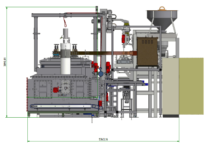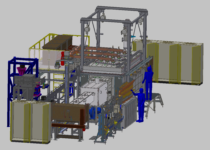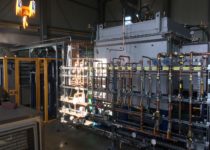CARBIDE2500
CARBIDE2500 is a “From concept to market – Phase 2” activity that was sponsored by the Executive Agency for Small and Medium-sized Enterprises (EASME) of the EU (Horizon 2020 Framework Program).
Title of the Project
“The first 2500°C industrial furnace, for higher efficiency and up to 5 times higher strength materials”
Project Duration
24 months, started on 1st Mai 2018, successfully completed end of April 2020
Tungsten Carbide (WC)
Tungsten Carbide (WC) is a high performance material composed of Tungsten (W) and Carbon (C). This inorganic non-natural compound, exhibits a hexagonal structure made of a grid of Tungsten and Carbon, that confers it unique properties. Not only does it have a hardness second only to that of diamond, it also has a high density, melting point, strength and a high electric and thermal conductivity. Furthermore, the compound tungsten carbide is easily molded into many shapes, can be sharpened with precision, and can be melded with or grafted to other metals.
High quality tungsten carbide powder is needed to produce cemented carbide, an extremely successful composite engineering material made up of between 70-97 percent by weight of WC-powder. WC powder is mixed with the binder metal, compacted in a die and then sintered in a furnace to produce a cemented carbide. Parts made using cemented carbide are resistant to heat, wear and pitting. Therefore industrial tools made using cemented carbide components are primarily used for applications where they are subjected to great stress, for example drilling, mining, milling and grinding. Due to their characteristics, such tools are relevant for the production of products in many industrial sectors, for example those producing aerospace, automotive, pump and seal, oil and gas, metal forming, metalworking, and hygiene products.
Another important application of tungsten carbide powder is the production of specialized alloys and composite materials containing other metals. Tungsten carbide can be combined with nickel, iron, silver, and copper to create specialized materials that are used in commercial construction applications, electronics, industrial gear making, radiation shielding materials, and the aeronautical industry.
One of the sectors, in which tungsten carbide also plays a significant role, is the development of new materials for the manufacturing of high density parts by additive manufacturing techniques, such as binder jetting and powder bed fusion (e.g. Selective Laser Sintering, Electron Beam Melting).
Production of Tungsten Carbide Powder
Tungsten carbide is formed by a chemical reaction between tungsten and carbon at very high temperatures of between 1450 °C-2500 °C. This process is called Carburizing or Carbonization. Reliably achieving these high temperatures in the high temperature process zone of thermal process equipment is a great challenge for plant manufacturers. They can be achieved in high-temperature pusher furnace systems with a graphite interior with a reducing atmosphere.
We at CREMER are specialized in high temperature processes under an inert or reducing atmosphere. We successfully design and construct pusher type furnaces for reducing, sintering, carburization, and calcination (Link: Pusher Type Sintering Furnace PTS, Refractory Metal Powders).
Influence of the Carburization Temperature (1600 °C, 2200 °C vs. 2500 °C)
During the CARBIDE2500 project a homogenized mixture of tungsten and carbon powder was carburized at 1600°C, 2200°C and 2500°C using a small-scale CARBIDE2500 furnace. For all of the tests carried out, the same input material was used. In addition, during each test run the same furnace atmosphere and dwell time were applied. The aim was to show the influence of the carburization temperature on the resulting WC powder produced, whilst keeping all other process parameters constant.
An analysis of the resulting WC powders shows that a higher carburization temperature leads to a significant grain growth. In addition the powder microstructure changes from a polycrystalline state at 1600 °C to a low polycrystalline and mono-crystalline particle structure at 2500 °C.

These promising results, based on one set of input parameters during testing as described above, led to many insights concerning possible future research to do with the potential of high-temperature carburized tungsten carbide powders and their potential to enable the production of hardmetal tools with enhanced mechanical properties. A lot was learned concerning the large number of variables involved, not only during the carburization process, but also concerning the production of high quality hardmetal. As a result, the project aims were changed accordingly, with the emphasis being placed on showing the suitability of the innovative small-scale CARBIDE2500 furnace technology to investigate the influence of the relevant process parameters. It is also suitable for producing smaller batches of high temperature carburized WC powder. In addition, our larger furnaces are capable of carburizing tungsten and tantalum at process temperatures of up to 2500°C on an industrial scale.
Conclusion
The CARBIDE2500 furnace type has been confirmed to be capable of a carburization temperature of up to 2500 °C with a furnace atmosphere of either N2, H2 (+CH4) or Argon. The furnace technology is suitable for the carburization of tungsten to tungsten carbide, but also of tantalum to tantalum carbide. In addition, it is suitable for graphitization. The small-scale CARBIDE 2500 furnace used for the demonstration tests during the CARBIDE2500 project is located at CREMER Thermoprozessanlagen GmbH in Germany. It is available for testing for clients who wish to investigate the potential of the high process temperature for either carburization processes or graphitization.

“This project has received funding from the European Union‘s Horizon 2020 research and innovation programme under grant agreement No 811248“


